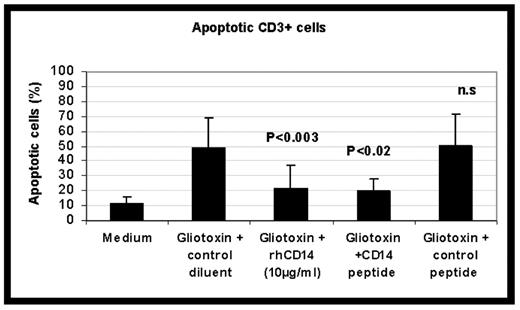Abstract
CD14, a 56 Kd glycoprotein, typically present on myeloid cells, has been traditionally associated with innate immunity and pattern recognition. Recently its membrane bound form has been shown to be involved in apoptosis, as a tethering receptor for apoptotic cells on the surface of phagocytes-in this case with the purpose of removing apoptotic cells, and also as a surface molecule involved in protection from apoptosis of monocytes, neutrophils and recently on enterocytes, challenged with LPS.
Our aim was to evaluate the possible involvement of the soluble CD14 in the apoptotic pathway of human lymphocytes.
Methods: Freshly obtained human peripheral blood lymphocytes were cultured in vitro with gliotoxin, an apoptotic inducer. Human recombinant CD14 was added to the culture at physiological concentrations (10μg/ml-0.5 μg/ml) and apoptosis was assessed by cell membrane integrity using 7AAD, mitochondrial membrane potential by DiOC6(3) and cytoplasm shrinkage by cell size scatter analysis.
Results: Using DiOC6(3) we were able to show that human lymphocytes cultured in the presence of gliotoxin contained 63.8%±21 apoptotic cells, as opposed to 12.2%±11.5 in control cultures. Addition of recombinant human CD14 at a concentration of 10 mg/ml neutralized the apoptotic effect of gliotoxin back to 20.2%±10 (p<0.003). This inhibitory effect was blocked by CD14-specific monoclonal antibodies, but not by control antibodies. We then identified and synthesized the fragment within the CD14 molecule that was responsible for this apoptosis protective effect, and demonstrated its comparable protective efficacy in vitro as shown in figure 1. The figure clearly reveals that this specific peptide, as opposed to the scrambled peptide, protected the lymphocytes form apoptosis, similarly to the full CD14 protein. Same results were obtained using 7AAD and cytoplasm shrinkage.
Conclusion: Our data thus suggest that circulating CD14 may play an important role in the prevention of apoptosis of lymphocytes and perhaps of other cells.
Disclosures: No relevant conflicts of interest to declare.
Author notes
Corresponding author


This feature is available to Subscribers Only
Sign In or Create an Account Close Modal